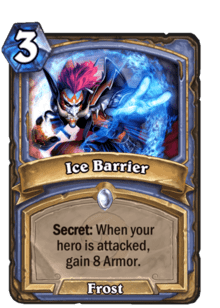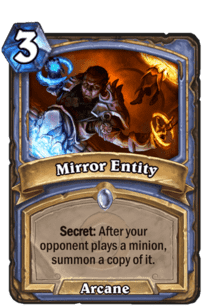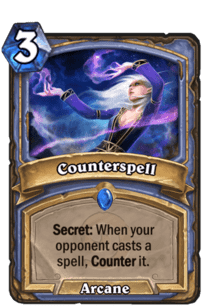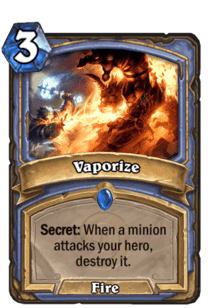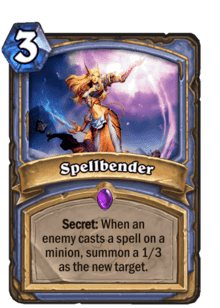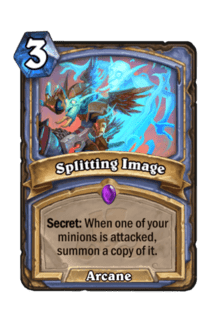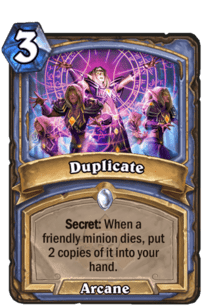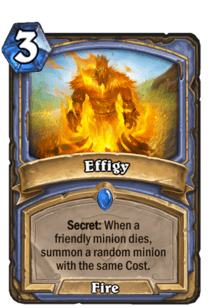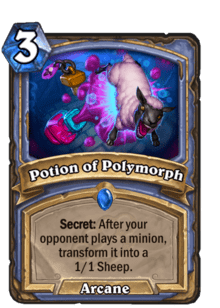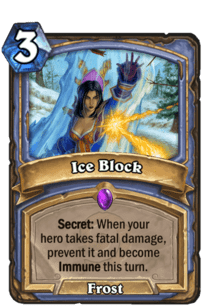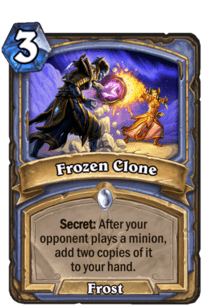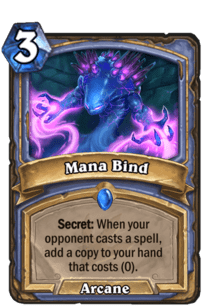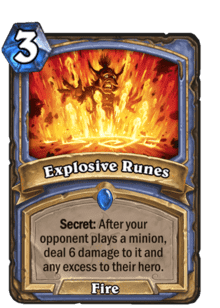Mage Secrets
Table of Contents
Secrets are spells that, when played, place a buff on the casting hero. This buff remains active until a specific action occurs, at which point the Secret is triggered, causing its effect, and being consumed.
While your opponent can see when you play a Secret (the question mark icon that appears next to your hero's portrait will be visible to them as well as to you), they cannot see which Secret has been played. All Secrets have the same mana cost within each class, meaning that the amount of mana you used on the Secret cannot indicate to your opponent what Secret has been played.
While multiple Secrets can be active on a hero at the same time, only one instance of each Secret can be active at once.
It is important to note that Secrets can only be triggered during your opponent's turn.
This article will present the Secrets, their mechanics, as well as how to counter them and how to play them most efficiently.
Mage Secrets and Their Mechanics
Mages have access to 13 Secrets, 6 in the Standard format and a further 7 are available in Wild. All Mage Secrets have the same cost of 3 Mana Crystals. We will list the Secrets and their rarity before going into more details below.
Standard Mage Secrets
Wild Mage Secrets
Secret Triggering Order
As a preliminary mention, it is important to keep in mind that the order in which Secrets were played affects the order in which they trigger. Specifically, whenever two or more Secrets which can be triggered by the same action are active at the same time, the Secret that was played first will trigger first.
There are a few notable interactions between Mage Secrets with respect to their triggering order, as we see below.
If both Counterspell and Spellbender are active, and a spell is cast on one of the Mage's minions, Counterspell will be triggered (because the spell never actually reaches the minion in order to trigger Spellbender).
If both Ice Barrier and Ice Block are active at the same time, and an attack is made against the Hero that would kill them, Ice Barrier will trigger first (and Ice Block will only trigger if the attack was large enough to deal lethal damage through the Ice Barrier and the hero's health). Note that in this case Ice Block would leave the hero with the remaining health and the 8 Armor from Ice Barrier (making it a sub-optimal play, to say the least). In case Vaporize is also active, it will be the only Secret that triggers, since the minion dying prevents it from attacking and triggering Ice Barrier or Ice Block.
Duplicate
Duplicate is triggered when one of the Mage's minions dies. When this happens, two copies of that minion are put into the Mage's hand.
There is nothing ambiguous or surprising about the way that this Secret works.
Ice Barrier
Ice Barrier is triggered when the Mage is attacked, and it grants them 8 Armor.
Only physical attacks count towards this Secret, meaning that if the Mage takes damage from a spell (whether from a card, a Battlecry, or a Hero Power), the Secret will not trigger. This means that it is indeed possible for the Mage to die with Ice Barrier active, if their opponent only uses spells against you.
Once triggered, though, the Armor will actually mitigate damage from all types of damage, including spell damage. Armor is nothing more than an extension of health.
Splitting Image
Splitting Image is the only Mage Secret that triggers when a minion is attacked. The Secret creates an exact copy of the minion being attacked before the attack is resolved, effectively duplicating the minion. This means that if both copies of the minion cannot be killed in the same turn, it is usually not worth triggering the Secret.
It is worth noting that, because the Secret only triggers when a minion is attacked, spells and Hero Powers can freely target the minion without triggering the Secret.
Mirror Entity, Explosive Runes, Frozen Clone and Potion of Polymorph
Mirror Entity, Frozen Clone, Explosive Runes and Potion of Polymorph are triggered when the Mage's opponent plays a minion. Mirror Entity summons a copy of that minion for the Mage, while Potion of Polymorph turns the minion into a 1/1 Sheep, Frozen Clone adds two copies of the minion that is played into your hand and Explosive Runes immediately deals up to 6 damage to the minion.
The wording here is important. The Secrets will only be triggered when the opponent plays a minion, meaning that if the minion is summoned as part of some effect other than being played from the hand as a minion card, they will not trigger. For example, Mirror Entity does not trigger its effect when a minion is summoned as a result of a spell or Hero Power (such as Shaman Totemic Call or Paladin Reinforce).
A very important issue regarding Mirror Entity concerns Battlecries. Since Battlecries are effects that take place when a card is played from the hand, and since Mirror Entity copies are summoned and not played from the hand, their Battlecries will not also be copied. For example, if Mirror Entity copies an Ironbeak Owl, its Silence Battlecry will not be usable. This applies even for Battlecries that do not require targeting, such as the Battlecry of the Mad Bomber.
That said, there is an important exception here. Mirror Entity copies the minion after it has appeared on the board, which means that if the minion has a Battlecry that affects it, Mirror Entity will basically copy that Battlecry as well. For example, if the Mage's opponent plays an Injured Blademaster, then Mirror Entity will copy a damaged 4/3 minion, and not a 4/7 minion, despite the fact that the Injured Blademaster is a 4/7 minion on its minion card. This is because the Injured Blademaster deals damage to himself and changes his stats as part of his Battlecry, and Mirror Entity copies it afterwards. The same applies to the Twilight Drake, the health of which changes as soon as it reaches the board.
Counterspell, Mana Bind and Spellbender
Counterspell, Mana Bind, and Spellbender all trigger under similar circumstances, so it makes sense to discuss them together.
Counterspell is triggered when the Mage's opponent casts a spell, and it counters it. This means that the effect of the spell does not take place, but the opponent's Mana Crystals and card are used up in the process. Counterspell does not apply to Hero Powers or Battlecries, being exclusive to spells that come from cards.
Spellbender is very similar to Counterspell, with a few key differences. Like Counterspell, Spellbender is triggered when the Mage's opponent casts a spell, but Spellbender is only triggered by spells that are cast on minions. So, while Counterspell will prevent a Fireball from hitting the Mage, or a Holy Light from healing the Mage's opponent, Spellbender will not be triggered by these spells, since they are not cast on minions. Examples of spells that trigger Spellbender are Blessing of Kings or Mind Control.
Like Counterspell, Mana Bind triggers on any spell that is played. It provides an exact copy of the spell played, with its Cost reduced to 0 Mana, allowing it to be played for free at the Mage's discretion.
When Spellbender is triggered, the spell is not countered, but instead a 1/3 minion is summoned for the Mage, and this minion becomes the new target of the spell. So, if Spellbender was triggered by a Blessing of Kings, then the 1/3 minion will receive the buff, and the Mage will end up with a 5/7 minion. If Spellbender was triggered by a Mind Control, the 1/3 minion will be mind controlled, and it will move over to the opponent's side.
Finally, we would like to mention that when all three of the aforementioned Secrets are up at the same time, and a spell that is cast would trigger all three Secrets, it is only Counterspell that will be triggered. However, in the case of just Spellbender and Mana Bind, both Secrets will trigger together.
Effigy
Effigy is triggered when one of the Mage's minions dies. When this happens, a random minion of the same cost as the minion that died is summoned for the Mage. This new minion is not restricted to the Mage's deck (it can be any minion in the game), and as with all summoned units, it will not play its Battlecry on appearing on the board.
Vaporize
Vaporize is triggered when the Mage is attacked by a minion, and it kills that minion. As the wording implies, the effect is only triggered by minion attacks (so Battlecries, spells, Hero Powers, or weapon attacks have no effect on it). The effect will kill any minion, even if it has a Divine Shield or an immunity effect (such as from Bestial Wrath) active on it.
It is important to note that when a minion triggers Vaporize, it dies before actually attacking the Mage, meaning that they do not take any damage from that minion.
Ice Block
Ice Block is triggered when the Mage takes fatal damage, and it causes the them to become immune for the remainder of the turn.
This means that if the Mage has 3 health, and it takes 4 damage, the 4 damage will trigger Ice Block, which will then prevent the 4 damage from affecting them. The Ice Block will remain active for the rest of the turn, meaning that the Mage cannot be killed.
Ice Block is triggered by any type of damage (minion attacks, Battlecries, spells, Hero Powers, weapons), and it also blocks any type of damage while it is active.
Kirin Tor Mage and Ethereal Arcanist
The Kirin Tor Mage and the Ethereal Arcanist are two minions which are very closely related to Secrets, so it makes sense to mention them.
The Kirin Tor Mage is a 4/3 minion with a Battlecry that causes the next Secret played during that turn to be free of cost.
The Ethereal Arcanist has a passive ability that causes it to gain +2/+2 at the end of every turn if the Mage has at least one active Secret. There is no limit to how much this buff can stack.
Countering/Detecting Mage Secrets
Whether you are playing against a Mage, or you are playing as a Mage, it is very important to learn how to counter and play around the Mage Secrets. We will approach this section as though your opponent was playing the Secret, but you can of course use the information if you yourself are the Mage, in order to understand how your Secrets may be countered.
Whenever a Mage plays a Secret, you will immediately need to make it a priority to find out what that Secret is, and to remove it at the smallest possible cost.
As soon as a Secret is played, you will have to do the following actions in an order that suits your current situation:
- attack the Mage with an expendable minion to test for Vaporize and Ice Barrier;
- kill one of the Mage's minions, the one that would be least beneficial for the Mage to get two copies of in their hand (in case the secret is Duplicate), and ideally one that costs little Mana (in case the secret is Effigy);
- play a very weak minion to test for Mirror Entity and Potion of Polymorph;
- play a high-Health or expendable weak minion to test for Explosive Runes;
- cast a very weak spell to test for Counterspell, Mana Bind, and (if possible) Spellbender.
If you have performed all of the above actions and none of them triggered a Secret, then the only other possibility is that the Secret is Ice Block.
Let us look at each Secret in a bit more detail. Remember that these actions do not need to be performed in a specific order, since they depend greatly on what your options are (whether or not you have weak minions on the board or in your hand, or if you have spells, etc.).
Vaporize and Ice Barrier
Both Vaporize and Ice Barrier are triggered from attacks made against the Mage. The optimal way to test for these Secrets is to attack the Mage with your weakest or most expendable minion, such as a Novice Engineer or a Silver Hand Recruit. In case the Secret is Vaporize, you will have only lost a very weak minion.
Naturally, if you know for a fact that the Secret cannot be Vaporize (if, in Play mode, the Mage had already played 2 Vaporize spells in that game), then it is safe to attack the Mage with any minion you like. It is also interesting to note that, since your weapon attacks trigger Ice Barrier, but not Vaporize, you can attack with your weapon first, if your only minion on the board is too important to risk losing to Vaporize. If your weapon attack triggers Ice Barrier, then you know it is safe to attack with your minion.
Mirror Entity, Explosive Runes, and Potion of Polymorph
Testing for Mirror Entity and Potion of Polymorph is as simple as playing a very weak minion. Note that your Hero Powers do not trigger Mirror Entity or Potion of Polymorph, if you are a Shaman or a Paladin, so you will need to actually play a minion from your hand.
You should try to play the minion that will be least beneficial for your opponent, or least costly for you to remove from the board later on, in case the Secret turns out to be Mirror Entity. For instance, if you are a Mage, you could play a Magma Rager, since you can easily kill this minion with a Fireblast, and its high attack value of 5 would not cause any problems to you.
Playing a very weak minion will also test for Explosive Runes in a similar way. However, any overkill damage will also be dealt to your Hero. If you have a high amount of Health, this is negligible, but if you are clinging to life, it may cost you to game. If you do not wish to lose any Health, you should try to play a minion with a high amount of Health (ideally 6 or more) with a low amount of Attack, such as Mogu'shan Warden.
Counterspell, Mana Bind and Spellbender
Testing for these three Secrets can sometimes be done at the same time, if you are able to use a spell that targets a minion. When doing so, you should again choose the weakest, most unimportant spell you have. For example, you could test it with an Ice Lance or a Holy Smite. If you are in a position where your opponent is clearly very vulnerable to your usage of a particular spell, your should not use that spell first, since it is very likely that they put up Counterspell or Spellbender especially to counter that situation.
In any case, you should be very wary of casting buffs when a Spellbender might be up. If you cast a Blessing of Kings on one of your minions and Spellbender triggers it, the Mage will end up with a very strong 5/8 minion.
Duplicate and Effigy
Playing around Duplicate is a bit difficult, since you will not often have a great variety of killable minions to choose from. In any case, if you have reason to suspect that the Secret is Duplicate, you should avoid killing a minion that would be particularly beneficial for the Mage to get in their hand (such as minions with Battlecries or Deathrattles that would be very detrimental to you in your respective situation).
Playing around Effigy is similar to playing around Duplicate, in that you want to have the secret be triggered by killing a weak minion, and not one that is expensive and whose death will result in another expensive (and therefore mostly likely strong) minion on the board.
Ice Block
It is not possible to test for Ice Block except through a process of elimination, or by killing your opponent. If you are in a position to do lethal damage to your opponent, and you suspect that they might have Ice Block up, there is something you can do to minimise its effect.
Since Ice Block prevents lethal damage and makes the hero immune for the remainder of the turn, it is inevitable that they will survive the turn, so there is nothing you can do about this. However, what you can control (depending on your options at the time) is how much health they survive the turn with. For example, if your opponent has 10 health left, and you can do 8 damage to them with a minion, and 2 with another minion, attacking them with the 2-damage minion first would cause them to become immune when taking the subsequent 8-damage attack, meaning that they would survive the turn with 8 health. Conversely, if you attack with the 8-damage minion first, Ice Block will not be triggered, since the damage is not lethal, and only the 2-damage attack would trigger it. This means that the opponent would survive the turn with only 2 health.
The idea is that when you suspect that Ice Block might be active, you should bring the hero as close to 0 health as possible before finishing them off.
Using Mage Secrets Efficiently
How to best use your Secrets as a Mage depends greatly on the situation in which you find yourself. To begin with, if you are building a Secret-heavy deck, it is advised to use both the Kirin Tor Mage and the Ethereal Arcanist as well, since they synergise very well. You should always try to combined your Secrets with these minions whenever possible. If you have a Kirin Tor Mage and a Secret in your hand that you would like to play, make sure to play the Kirin Tor Mage first. The Ethereal Arcanist is guaranteed to gain at least +2/+2 if you play him on a turn during which a Secret is active, and he may gain even more if you can keep him and the Secret up for additional turns.
We will go through each of the Secrets and give you the best uses for them, but again, remember that you are always going to take some risks when playing a Secret, since you never know for sure what actions your opponent will take. Experience with the game and knowledge of your opponent's mechanics will go a long way to ensure that you get more benefit from your Secrets.
Duplicate and Effigy
It is somewhat difficult to benefit greatly from Duplicate and Effigy, because it involves playing them and hoping that your opponent will kill the minion you desire them to kill. In most cases, this will be obvious to the opponent, and they will try to avoid it (by killing a weaker minion instead).
Duplicate and Effigy are probably best played when you are in a secure board position, so that several turns pass before your opponent can kill one of your minions, causing them to lose track of what your plans might have been. Likewise, if you are able to greatly pressure your opponent at the same time, they might simply be forced to kill a minion that will be beneficial for you in terms of Duplicate or Effigy.
It is important to remind you here that Secrets only trigger on your opponent's turn, so you cannot simply perform a trade and having the resulting minion death trigger the Secret, so watch out for that.
Ice Barrier
Ice Barrier is the easiest Secret to play. Basically, you should use this Secret whenever you can do so efficiently (if you have 3 Mana Crystals left and nothing else to use them on, for instance), since the Armor does not wear off after a certain amount of time. You can think of Ice Barrier as an 8-health heal.
Mirror Entity
Obviously, to gain the most benefit from Mirror Entity, you should have it copy very powerful minions. It is, however, impossible to tell for sure what minion your opponent will play the next turn, so there is always some risk involved. We will give you a few examples to illustrate the worst and best times to play this card.
If it is turn 2, and you have The Coin and Mirror Entity, this would normally be a very bad time to play the Secret, since your opponent is very likely to trigger its effect with a weak minion. Therefore, it is ideal to use this Secret later on in the game, when the bigger minions are usually played.
If it is turn 7, and you do not have board control (your opponent has 3 minions on the board and you have none, and no way to clear the board), this would normally also be a bad time to use the Secret. As soon as Mirror Entity would trigger, your opponent would have a variety of options for dealing with the newly-summoned minion, leaving you at a disadvantage once again. If your circumstances are quite desperate, however, you may be forced to play Mirror Entity in this situation if only to slow your opponent down.
The ideal time to play Mirror Entity is when you predict that your opponent will play a strong minion. For example, if it is turn 6 and you have a reasonably strong minion on the board, while your opponent has none, this is generally a good time to play Mirror Entity. It is likely that your opponent would feel compelled to play a strong minion to avoid falling behind too much.
Mirror Entity can also be quite useful extremely late in the game, in situations when both you and your opponent are out of cards in your hand, and are each more or less relying on the first cards you draw from your decks. In a situation like this, it is unlikely that your opponent would have a way to deal with your minion when it spawns, giving you the choice to kill the opponent's minion with it (assuming that the two minions can trade with one another), or simply to finish them off before they can finish you off (assuming that your health is higher).
The variety of situations is great, so we cannot really give any rules. Simply try to predict what your opponent will do, and use Mirror Entity when you feel it will be most beneficial.
Counterspell
Much like Mirror Entity, Counterspell is very useful if it counters a powerful spell, or a spell that would have been particularly problematic for you at a certain time. As such, you should avoid using Counterspell "whenever you get a chance", since it is likely to be used up by spells that do not change the game very much.
For example, playing Counterspell on turns 2-4 will is not normally a good idea, since the spells used here are unlikely to have a great impact on the game. Of course, an exception would be if you have several low-health minions on the board, and you are worried that your opponent will use a board-clearing ability to try to regain control. Using Counterspell at such a time could truly magnify your advantage by wasting your opponent's turn and leaving all your minions intact.
It is ideal to use Counterspell when you have some idea of what spells your opponent will use. For instance, if you are playing against a Priest, it is a bad idea to play powerful minions on or after turn 10, unless you have a way to remove these minions, since the Priest is likely to use Mind Control on them. That said, this is the ideal time to use Counterspell. If you use it during turn 6 (and your opponent does not trigger it) or turn 7, and then play a strong minion, the Priest will either waste their Mind Control on Counterspell, or they will trigger Counterspell with a weaker spell, which will then put them in a position where they cannot afford to cast Mind Control that turn.
Of course, any time Counterspell is triggered, this is a small victory for you, even if the spell itself was weak. So, do not hold on to Counterspell for a very long time, waiting for some ideal moment that may never come.
Spellbender
Spellbender should be used almost identically to Counterspell. If you have the option of playing both Secrets, but you have a good reason to think that the opponent will cast a beneficial spell, such as a Blessing of Kings, then it is best to use Spellbender.
Potion of Polymorph
Potion of Polymorph is difficult to use efficiently, given that playing around this Secret is quite easy by triggering it with a weak minion (which your opponents will often do anyway since this also checks for Mirror Entity). As such, for Potion of Polymorph to be truly effective (which is to say, for it to trigger against a strong or impactful minion) you will need to either predict your opponent's play very well, or otherwise be so far ahead that they have no choice but to play a strong minion.
It is worth noting that saving Potion of Polymorph for the late game can be beneficial, especially if you suspect your opponent's deck relies on big late-game threats.
Vaporize
Vaporize can be an extremely powerful tool if used at the right time. Naturally, the spell can easily be triggered by weak minions, costing your opponent very little, and your opponent will usually attack with a weaker minion first, whenever you have an active Secret. So, you should generally not use Vaporize when your opponent can make this type of decision.
For example, using Vaporize early, when your opponent has a couple of weak Murlocs on the board is generally a poor decision, since the Secret will not benefit you very much.
On the other hand, if it is later in the game and your opponent has one strong minion on the board (or a strong minion and one or more weak ones, assuming you can kill the weak ones with your Hero Power and/or some other spells), then Vaporize is ideal. In this situation, unless your opponent has a minion with Charge to send in and trigger Vaporize, they will either get their strong minion killed, or they will be forced to wait for at least one turn without attacking.
Ice Block
Unlike the other Secrets, Ice Block will only trigger when you really need it to, so it is possible, and indeed ideal, to use it as early in the game as you can afford to do so efficiently. Not only will it still be active when you need it (unless a Hunter uses Flare, but this is rather unlikely), but it will also force your opponent to play conservatively while they check to see what Secret you have active.
Ice Block is particularly useful against opponents who attempt to deal a massive amount of damage in a single round, such as Murloc or Unleash the Hounds rushes. These decks rely on getting the kill on the respective turn, and are likely to run out of momentum after that, since Murlocs and cheap Beasts have very low staying power. As a Mage, you are likely to have various methods of removing these minions on the next turn, or of finishing the hero, so Ice Block can truly be a life-saver in these situations.
Changelog
- 10 Apr. 2019: Guide has been re-organised to reflect Standard Secrets in the Year of the Dragon.
- 07 Dec. 2016: Added Potion of Polymorph to the list of Secrets.
- 05 Jul. 2016: Clarified the order in which Secrets are triggered.
- 23 Aug. 2015: Added Effigy to the list of Secrets.
- 26 Aug. 2014: Added a mention that Secrets can only be triggered on the opponent's turn, and added Duplicate to the guide.
- No BlizzCon in 2024
- Blizzard Games Return to China: New Agreement Signed With NetEase
- Blizzard Reportedly Reuniting with NetEase to Bring Back WoW in China
- Ex-Activision Blizzard CEO Bobby Kotick Shows Interest in Buying TikTok
- Timeline of Blizzard Presidents
- Johanna Faires Appointed Blizzard Entertainment President
- Will Microsoft Outsource Customer Support to External Companies?
- Blizzard Survival Game, Codenamed Odyssey, Was Cancelled Due to Engine Problems
